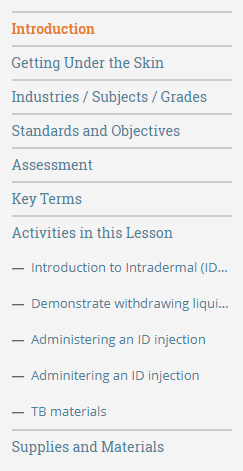Health Science | CTE Online | Medical Assisting
REVIEW: CTE Online's Medical Assistant Curriculum
For nearly 10 years, Bri has focused on creating content to address the questions and concerns educators have about teaching classes, preparing students for certifications, and making the most of the iCEV curriculum system.
Textbooks for introductory health science courses are easy to find for high school teachers.
But when it comes to teaching a specialized course on medical assisting, finding the right instructional materials is a challenge.
We often hear this from health science instructors across the United States. While most instructors tend to look for a textbook, other resources are out there!
CTE Online is a common solution for teaching medical assistant courses. It has an outline with specific lessons to teach medical assisting in high school.
In this post, we’ll explore the pros and cons of the CTE Online medical assistant curriculum and give you some ideas for using it in the classroom.
Let’s get started!
About CTE Online

CTE Online is a website dedicated to providing resources to CTE teachers to help them succeed in the classroom.
CTE Online is geared towards teachers in California, but any CTE teacher can use it.
All of the content on the site is provided by educators in the specified field, so you know the medical assistant curriculum is written by subject matter experts.
It’s free and easy to join CTE Online. Once you create an account, you can use anything on the site.
CTE Online’s High School Medical Assistant Curriculum

CTE Online titles its medical assistant curriculum “Medical Assistant Model (Advanced Healthcare Administrative Services) - CTE Online Model.”
There are two sections of the curriculum -- Medical Assisting Core and Medical Assisting Clinical.
The Medical Assisting Core covers the skills all medical assistants need to perform. It was designed to provide a good foundation for all students, whether they will continue into the administrative or clinical parts of the program.
The Medical Assisting Clinical section is more detailed and related to the “back office” duties of a medical assistant.
In general, the curriculum is meant to prepare students for working at a clinic or physician’s office.
The expected outcomes for a student being taught from this curriculum model include:
- Showing knowledge of anatomy and physiology
- Showing knowledge of vital signs
- Performing CPR
- Constructing patient charts
- Calling in prescriptions
- Answering phones and confirming appointments
The Medical Assistant course model has 17 units (called “subject areas”) with an estimate of 180 hours of class and lab work.
The main page of the model shows an overview of each unit, the hours per unit, and links to the lessons within each unit.
Some of the units include:
- Medical Assisting Profession
- Infection Control and Universal Precautions
- Safety in the Medical Office
- Medical Ethics and Legal Considerations
- The Patient Record
- Medical Terminology
- Diagnostic Tests, Examinations and Therapeutic Modalities
Each unit varies in the number of lessons it includes. Some only have one lesson, while other have half a dozen or more.
Next, we’ll review how the lessons are laid out.
How the Medical Assistant Lessons Are Organized
Each lesson on CTE Online has the same layout, making it easy to know what you will find.
Lessons start by listing the course creator with a link to the author’s information. You can read their bio to see what they teach in health science and other items they have shared on the site.
Beneath that, you see the lesson plan and resources.
The lesson plan includes an introduction, time to complete the lesson, objectives, and instructions for you to follow.
Some of the lessons include assessments and extra resources like worksheets, activities, guided notes, projects, demonstrations, and quizzes.
The most important section in each lesson is the “Activities in this Lesson” area. This section contains the lesson instructions and the related resources you will need to teach it.
Many lessons also include additional resources such as video clips, PowerPoints, worksheets, and links to online articles.
Overall, you will find a lot of information and content to mix up your teaching style in a blended approach.
What Are the Pros of the Medical Assistant Curriculum?
CTE Online’s medical assistant curriculum can be a big help for many health science instructors.
There’s a lot of detail in the lessons and activities. That means the resource can be the base for your curriculum to help you save time in planning and preparing.
Another benefit is the fact that the lessons and resources are provided by health science instructors and professionals. That means the creators are knowledgeable and experienced with the subject matter.
Finally, all of the content within the curriculum model is created with high school students in mind. The information is perfect for your students!
What Could Be Improved?
As with any free online resource, the medical assistant curriculum has a few cons.
While there are a lot of resources available, many of them are scans of textbook and workbook pages. This means they are often blurry or pixelated. Because of this, you may need to spend time recreating them yourself in order to provide good materials for your students.
Another problem that could throw off your planning is the lack of standardization of what an “hour” means. This is due to the fact that the resources are added by different creators. In some cases an “hour” refers to a shorter class period (45-50 minutes) and in others it means a scheduled block period (80 minutes).
In order to properly plan your syllabus using the lessons, you will need to review each one to see the estimated time it will take.
How to Use the Medical Assistant Curriculum

So with all of these lessons and resources available, how can you use them in your medical assisting classes?
The first step is to map the lessons to your medical assistant course standards (if any apply to you).
By mapping the lessons and activities to standards, you can be sure to have an organized syllabus. It will also help you see where you may have holes in topic coverage that will need to supplement.
Once you have aligned CTE Online’s lessons to your course standards, it’s time to figure out your implementation plan.
We suggest you try a blended learning strategy. Because the curriculum includes a large variety in lessons and activities, you have a lot options for lecturing, discussions, group work, homework, and more.
You could even take the blended learning strategy a step further and incorporate another resource such as HealthCenter21.
How Does HealthCenter21 Work with CTE Online?
As a digital curriculum system, HealthCenter21 is a great complement to the CTE Online medical assistant model.
HealthCenter21 includes digital lessons for students to work through at their own pace, which is crucial in providing differentiated lessons on detailed medical assistant topics.
Also, where CTE Online has rubrics and checklists for manual assessments, HealthCenter21 has automatically graded quizzes and tests that let you quickly check for student comprehension.
Combining the two can help you ensure no course standard is missed and always provide your students with the best experience in the classroom.
For more ideas to use blended learning in your health science classroom, check out this free guide on 4 Strategies for Using Blended Learning in CTE!


